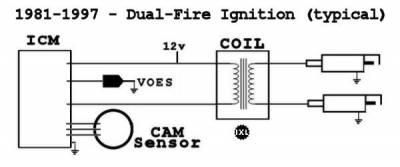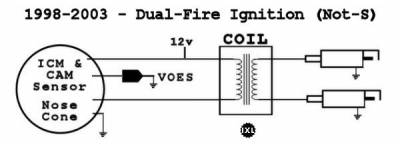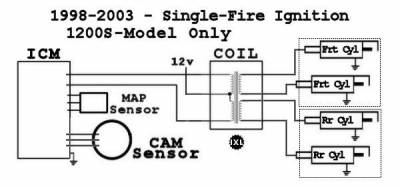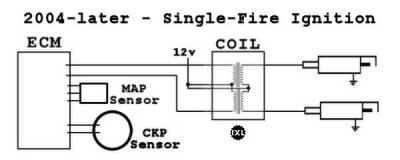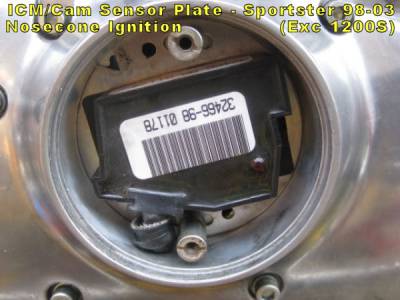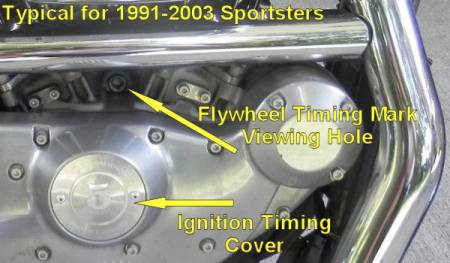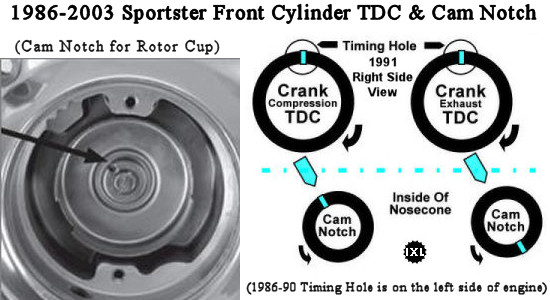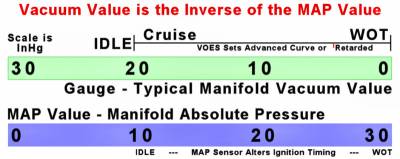Table of Contents
EVO: Engine Control
IGNITION, COIL, PLUGS & VOES
Sub Documents
Electronic Ignition Modules
1980-1997
The components for the ignition system includes a timing rotor (timing cup), sensor plate with an inductive pickup, ignition control module, ignition coil and spark plugs. The inductive pickup generates Top Dead Center (TDC of piston) pulses that are sent to the solid state Ignition Control Module (ICM). The ICM computes ignition timing advance and coil dwell. A Vacuum-Operated Electric Switch (VOES) is used (since 1983) to switch between 2 different spark advance curves built into the ICM. 1) These advance curves were modified over the years as indicated by the Curve Letter printed on the modules (such as G, J, K, Q). Some of the variation in the P/N was to designate different terminations of the module cable (such as direct wire or 7-pin plug or 8-pin plug).
The ICM for these years uses a Dual-Fire Spark system. The dual-encapsulated coil is fired by only one coil trigger wire from the ICM. This produces a spark on both plugs at the same time, regardless of which cylinder is currently under compression. Therefore, there is a dual-spark created when the front cylinder is near TDC and there is another dual-spark created when the rear cylinder is near TDC. (See coil information below)
The spark advance (curve) starting point can be altered by physically rotating the sensor plate which is located in the 'nosecone' behind the round cover.
| Ignition Control Modules (Latest Known Superceding Version) | ||||||
|---|---|---|---|---|---|---|
| 883 Models | '86-'87 1100 Models | |||||
| Year | Part No | Curve | RPM Limit* | Part No | Curve | RPM Limit* |
| 1986 | 31410-91B | G | 6000 | 32410-91B | G | 6000 |
| 1987 | 32410-91B | G | 6000 | 32410-91B | G | 6000 |
| 883 Models | 1200 Models | |||||
| Year | Part No | Curve | RPM Limit | Part No | Curve | RPM Limit |
| 1988 | 32410-91B | G | 6000 | 32432-91B | J | 6000 |
| 1989 | 32410-91B | G | 6000 | 32433-91A | M | 6000 |
| 1990 | 32410-91B | G | 6000 | 32433-91A | M | 6000 |
| 1991 | 32410-91B | G | 6000 | 32433-91A | M | 6000 |
| 1992 | 32410-91B | G | 6000 | 32433-91A | M | 6000 |
| 1993 | 32410-91B | G | 6000 | 32433-91A | M | 6000 |
| 1994 | 32410-94A | G | 6000 | 32433-94 | M | 6000 |
| 1995 | 32410-94A | G | 6000 | 32433-94 | M | 6000 |
| 1996 | 32466-95A | R | 6000 | 32465-95A | Q | 6000 |
| 1997 | 32466-95A | R | 6000 | 32465-95B | Q | 6000 |
* - 5800 RPMs listed as maximum safe, but cut-out RPM Limit mentioned as 6000 in Owner's Manual (99466-xx under 'Operation')
The 1986-1997 Ignition Control Module was located under the
Triangle Cover on the left side of the bike next to the battery.
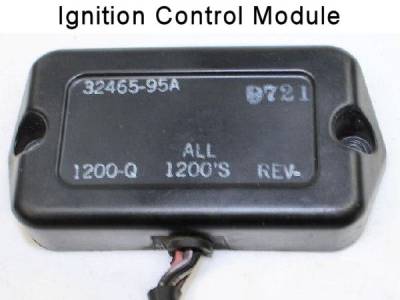
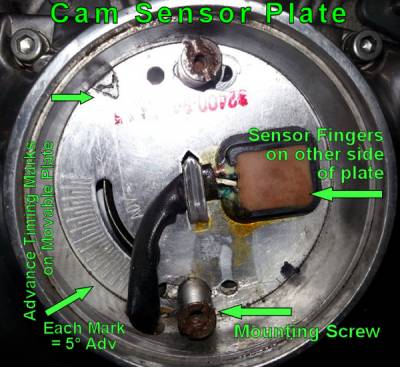
1998-2003
The 1998-2003 Non-Sport model used an integrated ICM on the Sensor Plate (which was still located in the 'nosecone' behind the round cover) and was still a Dual-Fire Spark System. A Bank Angle Sensor (BAS) was also connected to the ICM as an interlock to stop the engine & prevent restarting the engine if the bike was on it's side.
These OEM modules had a high failure rate, apparently due to the high heat in their mounting location. The MoCo stopped providing replacement units as soon as they were allowed. The only current choice for replacement is aftermarket versions (such as the Ultima brand discussed HERE or the equivalent from another brand).
The ICM may fail with a number of different symptons, with some randomness. The bike may refuse to fire even though the starter will turn the engine over. Some riders report that flicking the RUN/STOP switch (which sends power to the ICM and the coil) several times will sometimes allow the bike to fire up. The ICM may also fail due to heat even though it fired up cold. In this case, once the engine cools down, the ICM may allow the engine to fire up again. This can be extremely frustrating as the bike will randomly stop while riding. Various other, less common, symptoms may occur from a failing nosecone ignition module (misfiring, backfiring, etc.).
There are two methods of testing the ICM relative to heat failures. Method One makes the ICM fail when the engine is cold, while Method Two tries to make the ICM begin functioning again after it has failed due to heat.
Heat Test - Method #1 - If the bike usually fires when cold but dies when warm/hot, test the ICM with the engine cold. With a cold engine, use a hair dryer to blow heat on the ICM (in the nosecone) before attempting to start it. After it's warm, see if the engine fails to start due to the spark missing or intermittent.
Heat Test - Method #2 - The alternative is to use Cold Spray (see note below). Once you have a running failure from heat, use the cold spray to quickly cool down the ICM (in the nosecone). If the ICM has failed due to heat, this test will check to see if it will begin to produce a spark again after being cooled down.
Somtimes, these two methods can be used in combination to create & resolve a failure condition, although heat related problems can still be hard to diagnose/resolve. The same two procedures can be used to test the ignition coil (or other aftermarket ignitions or misc. electronic components) for heat failure.
'Cold Spray' is a different form of the 134A A/C coolant. It can also be labeled as 134 Spray, 134A Spray, Freeze Spray, Component Cooler, etc. One version is Chemtronics Duster ES-1017. Don't confuse this with other medical-type freeze spray which should not be used because they include topical ingredients. Be sure the product you get has No Residue. The right product is pure 1,1,1,2-tetrachluoroethane.
The 1998-2003 1200Sport model used an independent Ignition Control Module and the same Sensor Plate as the 1986-1997 models. The 1200Sport model pioneered the Single-fire Spark system and the Manifold Air Pressure sensor (MAP) for the future Sportster models.
Like the other 1998-2003 models, the 1200Sport ICM is no longer available from the MoCo. Some have converted to using the aftermarket nosecone ICM as mentioned above for the non-1200Sport models. (See Aftermarket Ignition Swap: https://www.xlforum.net/forum/sportster-motorcycle-forum/sportster-motorcycle-electrical/sportster-motorcycle-electrical-and-ignition/130785-sportster-sport-1200s-98-03-ignition-replacement?t=1382357 2) )
| OEM Ignition Control Modules (Latest Known Superceded Version) | ||||
|---|---|---|---|---|
| Year | Model | Part No | Timing* | RPM Limit* |
| 1998-2003 | 883 | 32466-98B | 20° | 6000 |
| 1998-2003 | 1200 | 32465-98B | 20° | 5200 |
| 1998-2000 | 1200Sport | 32480-98A | 20° | 5500 |
| 2001-2003 | 1200Sport | 32480-01 | 15° | 5500 |
* - Spark Timing (always BTDC - Before Top Dead Center) is set with engine at approx. 1000 RPMs
* - See Recommended Max RPM Limit mentioned in Owner's Manual (ie., 99468-01 Pg75 under 'Operation')
| 1998-2003 1200S - ICM PINOUT | ||||||
|---|---|---|---|---|---|---|
| GRAY Connector 11 | … | BLACK Connector 10 | ||||
| Pin 1 | RED/White | 5v Sensor Power to CPS & MAP (out) | … | Pin 1 | WHITE/Black | Power - Run/Stop Sw - Data Link (Pin4) |
| Pin 2 | VIOLET/White | Signal from MAP Sensor (in) | … | Pin 2 | BLACK | Harness Ground - Data Link (Pin2) |
| Pin 3 | GREEN/White | Signal from CPS (in) | … | Pin 3 | NoConnection | |
| Pin 4 | No Connection | … | Pin 4 | BLACK/Yellow | CEL Light (On=Gnd) | |
| Pin 5 | No Connection | … | Pin 5 | NoConnection | ||
| Pin 6 | No Connection | … | Pin 6 | BLUE/Orange | Front Coil Trigger | |
| Pin 7 | No Connection | … | Pin 7 | YELLOW/Blue | Rear Coil Trigger | |
| Pin 8 | BLACK/White | 5v Sensor Ground on ICM | … | Pin 8 | NoConnection | |
| Pin 9 | No Connection | … | Pin 9 | NoConnection | ||
| Pin10 | No Connection | … | Pin10 | LtGREEN/Gray | Bank Angle Sensor (in) | |
| Pin11 | LtGREEN/Red | Data Link (Pin1) | … | Pin11 | BLACK | Harness Ground |
| Pin12 | VIOLET/Red | Data Link (Pin3) | … | Pin12 | PINK | Signal to TACH (RPM out) |
2004-2006
The Ignition Control Module (ICM) for 2004-2006 became more capable and included a digital communications link (SDB) between itself, the Turn Signal Module and the Speedometer. This new Serial Data Bus (SDB), using an accessible data port on the side of the bike, also allowed the ICM to be dealer programmed for either 883 engines or 1200 engines, with upgrades as well.
The newly added Crankshaft Position Sensor (CKP) replaced the camshaft pickup as a more advanced means of sensing the engine revolutions and the new Manifold Air Pressure sensor (MAP) replaced the VOES as a more advanced means of sensing engine loads. The ignition system gives a spark near top dead center for starting. Then, at running RPM and loads above this, the system gives a spark advance that varies between 0 and 40. (For further information, see the section below titled: 2004-later Single-fire Spark Synchronization)
From this point forward, all the Sportster models used a Single-fire Spark system, using two individual coil trigger wires to produce a spark on individual spark plugs, one at a time. (see coil information)
The Ignition Control Module for these years is programmable by the dealer to match the specific model bike, either 883 or 1200. It is mounted under the seat. The part number on the ignition module is really the version of the internal software that was last flashed into the module. The module may have started out as a 32478-04 (or 32622-04) module, but it might then have been upgraded to 32622-04A. Later built models would have had the latest upgraded part (software) installed from the factory. As of 2020, the 32622-04C is listed as correct for all 2004-2006 models (then programmed for 883 or 1200) and older modules are recommended to be upgraded to that level.
It is believed that the stock RPM Limit is set for 6000 for 883 models and 5500 for 1200 models3). The 2005 Owner's Manual says that 6000 RPMs is the maximum safe RPM but does not specify to which engine version that applies. The 883 Tuning Image on TechTip#58-2004-12-06 shows a Rev Limit of 5500 RPMs. For various models, some owners have suggested 5400, 5800 or 6000.
If the module is replaced for any reason, see the Password Learn Procedure HERE.
2007-2013
With the implementation of Electronic Fuel Injection, the Electronic Control Module (ECM) for the 2007-2013 models is the heart of the ignition system. It obtains inputs and controls outputs as listed below. This expanded capability for the ECM allows it to be programmed in minute detail to account for changing conditions in the operating engine.
The ECM obtains input information from:
- Manifold Air Pressure Sensor (MAP)
- Crank Position Sensor (CKP)
- Engine Temperature Sensor (ET)
- Intake Air Temperature Sensor (IAT)
- Oxygen Sensors in Exhaust (two) - (O2)
- Throttle Position Sensor (TPS)
- Vehicle Speed Sensor (VSS)
The ECM controls the following outputs:
- Serial Data Bus (digital) for Turn Signal Module & Speedometer
- System Power Control thru System Relay
- Idle Air Control (IAC)
- Fuel Injectors in Heads (two)
- Coil Firing Sequence - Single-Fire using Encapsulated dual-coils
The part number (as of 2020) for this factory/dealer programmable ECM is 32534-11 and is usable on the 883 or 1200 models when properly programmed. If the module is replaced for any reason, see the Password Learn Procedure HERE.
It is believed that these stock modules have an RPM Limit set to 6000 RPMs.4)
2014-later
To further expand the computerization of the Sportster, the ECM for the 2014-later models was equipped with a Controller Area Network Bus (CANBUS) and the Body Control Module (BCM) was added. In general terms, the CANBUS replaced the digital communications between the smart controllers (in place of the Serial Data Bus) and allowed computerization of the handlebar controls, while the BCM replaced the Turn Signal Module and handled power distribution throughout the bike, including to the lights and other components. The BCM also eliminated all relays.
| Year | Module P/N | Function |
|---|---|---|
| 2014-2016 | 41000006A | ECM |
| 2017-2020 | 41000326A | ECM |
| 2014-2020 | 41000341E | BCM w/Sec (NotAvailable?) |
| 41000351F | BCM w/o Security |
It is believed that these stock modules have an RPM Limit set to 6000 RPMs.5)
Password Learn Procedure: If the ECM or TSM/TSSM/HFSM are replaced, you may need to follow the Password Learn Procedure before the bike will operate correctly. If the procedure is not followed, the engine will start and run for a few seconds, and then stall. This will typically throw a P1009 diagnostic code. See this section of the Sportsterpedia for the Password Learn Procedure.
The Sportsterpedia has a listing of Aftermarket Ignitions in the REFerence section.
Ignition Timing - Adjustable 1986 Thru 2003
- Ignition timing is when the spark takes place - specifically as the piston is traveling UP on the COMPRESSION stroke (compressing the gasses so that you get the most out of the explosion/ignition). 6)
- Top Dead Center is when the piston is at the VERY top of its travel, in the center of it's dwell area, and is usually referenced to mean on TDC of the COMPRESSION stroke (with the valves closed and the mixture compressed), though the piston will also be at TDC on the Exhaust stroke when the flywheel turns one complete rotation in either direction from TDC of compression. 7) So, the piston will be at TDC twice per 1 full revolution of the cams. Timing is measured (and set) from TDC on the compression stroke. Check below for the images of cam notch on timing rotor position relative to TDC Compression or see more on Finding TDC on Compression Stroke in the Sportsterpedia.
- Spark ADVANCE - is how soon, BEFORE the piston reaches top dead center (all proper timing is BEFORE TDC) that the spark plug fires to start burning the mixture. The faster the motor is turning, the sooner you need to start the ignition (more advanced it needs to be) so that the power of the expanding gasses starts pushing on that piston as soon as it starts moving downward and pushes as long as will be beneficial. 8)
| The timings and rpms in the following chart are from the Factory Service Manuals for the various years. | |||||
|---|---|---|---|---|---|
| Year | 0°=TDC Timing Mark | 20°BTDC Adv Timing Mark | 40°BTDC Adv Timing Mark | Timing Hole on Engine | Notes |
| 1986-90 | Vertical Line | None | Single Dot | Left Side | Set Idle = 1650-1950rpm - Use Timing Light - Look for Single Dot (40°) - 4sp Trans Models |
| 1991-95 | Vertical Line | None | Single Dot | Right Side | Set Idle = 1650-1950rpm - Use Timing Light - Look for Single Dot (40°) - 5sp Trans Models |
| 1996-99 2000-03 | Vertical Line | Double Dots | Some-SingleDot | Right Side | Set Idle = 1000-1050rpm - Use Timing Light - Look for Double Dots (20°) 2000-2003 have Press Fit Flywheel |
| 2001-03 1200S models | These models need a Dynamic Timing of 15° BTDC when at Approx. 1000rpm (The ICM changed curves for these years)11) | ||||
| The Timing Hole Plug (HD P/N 720) can be removed with a 3/8“ Allen Hex Key - It has 5/8-18 threads | |||||
| Some 1996-2003 flywheels have a Single Dot to indicate 40° BTDC when engine rpm is ~3500 rpms | |||||
| 2004-later | No Timing Hole or Timing Marks on Flywheel - Base Timing is set in programmable Engine Control Module using CKP Sensor at Flywheel Teeth | ||||
All models between 1986-1997 used a movable Cam Sensor Plate with the ignition module located elsewhere. The 1200S model continued to use this configuration from 1998-2003. But in 1998, except for the 1200S models, the ignition module was incorporated onto the Cam Sensor Plate. The combined ICM/Cam Sensor Plate (aka Nosecone Ignition) provided for dynamic timing (engine running - moving plate) in the same way as before, plus it also allowed Static Timing (engine not running).
The timing hole (in the engine case) was located from 1986-1990 on the left side of the engine & from 1991-2003 on the right side of the engine. In 2004, with the introduction of the CKP Sensor for timing, the nosecone cavity was empty and timing adjustments required programming the new Engine Control Module with a computer. There is no timing hole on the 2004-later models.
The movable plate (either separate or integrated version) is used to set the base timing for the ICM advance curves. Since there is no marked TDC or advance timing position marked on the plate itself, the timing plate will be set while viewing the flywheel advance timing marks on a running engine. Correct timing is always set on the compression stroke of the front cylinder(both valves closed).
The timing marks on the flywheel can be seen thru the timing hole, which is situated on the left or right side of the engine, on the crankcase just below the cylinders. The timing hole plug can be removed with a 3/8” Allen Hex Key. Removing the Timing Hole Plug allows you to find the timing marks by peering into the hole. Use the clear timing plug when doing a dynamic setting of the timimg with a timing light flashing into the clear plug to highlight the marks on the flywheel.
Static TDC Timing for the 1998-2003 Models (Not-S)
Important: Be sure you are on the compression stroke of the front cylinder when setting the Static Timing. When you rotate the engine (as follows) be sure you feel the pressure in the front cylinder spark plug hole is building up as you rotate toward the TDC mark. Turn the engine over as often as necessary to guarantee you are on the compression stroke of the front cylinder.
The Nosecone Ignition unit (98-03 not-S) can be statically timed (without the engine running) using the built-in LED. The procedure is to manually rotate the engine (bike on lift, 5th gear, rotate rear tire to rotate engine) to position the engine to TDC (front cylinder compression stroke) using the timing hole to look for & center the vertical line. Then, turn the ICM/Cam Sensor Plate slightly clockwise & counterclockwise to find the exact spot where the light switches between on & off - Lock down the plate.12) In this way, the ignition module is synchronized to the engine (TDC) so that it can effectively calculate the proper time to fire the spark plug BEFORE TDC.
Static TDC Timing for the 1998-2003 Sport Model
Important: Be sure you are on the compression stroke of the front cylinder when setting the Static Timing. When you rotate the engine (as follows) be sure you feel the pressure in the front cylinder spark plug hole is building up as you rotate toward the TDC mark. Turn the engine over as often as necessary to guarantee you are on the compression stroke of the front cylinder.
- With the transmission in 5th gear and the timing hole plug removed, rotate the rear tire to rotate the engine until the TDC mark is centered in the hole. The TDC mark is the Vertical Bar. This must be on the compression stroke of the front cylinder.
- Connect the BLACK probe of a multimeter (set on the 20v DC scale) to a good ground (Batt Neg, Frame, etc. or to Pin8 of the Gray ECM connector). Connect the RED probe to the ECM Gray Connector, Pin3, GREEN/White wire. This pin has the signal from the Cam Position Sensor (CPS). (Note: The '98 service manual incorrectly identifies Pin1 as that signal - do not monitor Pin1 which is the power to the sensor.)
- Remove the cover of the nosecone, where the CPS Plate is located. Important: Place a reference mark on the plate and on the sidewall of the nosecone.
- Loosen both tall mounting screws on the CPS Plate and rotate the plate counter-clockwise a small amount.
- Now, turn the Keyswitch ON fully, set the RUN/STOP switch to RUN and watch the multimeter. It should be reading >4v at this time. If not, rotate the Plate a small amount more counter-clockwise until the meter reads >4v DC.
- Now, rotate the CPS Plate clockwise, very slowly, until the meter reads <1v DC. That is the Static Timing point for TDC. Once you are sure you are exactly on the change between >4v & <1v, lock down the tall mounting screws to secure the CPS Plate in that position.
- Turn off the keyswitch & remove the meter & close the nosecone.
Setting the Dynamic Timing
To set the timing dynamically, with the engine operating, first, remove the timing plug & install the clear timing hole viewer plug (It MUST NOT touch the flywheel but needs to be as close as possible). Connect the clamp of an inductive pickup timing light (powered by the battery) to the front spark plug wire. This will allow you to 'shoot the light' into/thru the clear viewer plug. Then start the engine, set the idle for 1986-1995 models at 1800RPMs (40° timing - single dot) or set the idle for 1996-2003 models at 1000 RPMs (20° timing - double dots). Then shoot the light into the timing hole. Move the timing plate so that the proper advance timing mark shows up in the center of the timing hole. For 01-03 1200S models, estimate the specified 15° BTDC at 1000RPMs based on the 20° flywheel mark, using the tick marks on the Cam Sensor Plate as a guide or use a dial back timing light.
Moving the Cam Sensor Plate Clockwise (CW) will increase the Advance Before TDC. Moving the plate Counterclockwise (CCW) will retard (or reduce) the Advance Before TDC. TAKE NOTE that each timing mark on the plate (long-to-short) is equal to changing the ignition timing by about 5°. Move the plate VERY LITTLE to make adjustments. 13)
The Cam Sensor Plate can be rotated slightly to accomodate getting the timing mark in the center of the timing hole. You can also move the plate to change the base timing (thus moving both curve sets wholly up or down in all rpm ranges) by setting the timing to a few degrees more or less than the specified advance timing mark. For 1991-later models (right side window), you should be able to see the timing mark move to the right edge of the hole (more advanced) or the left edge of the hole (less advanced). You might find that a Timing Light with a Dial Back feature allows you to set a specific alternate timing setting using the TDC mark as a reference.
Some dial back timing lights have trouble working with the odd timing signals from a dual-spark 45° engine.
Adding more advance will increase the likelihood of pinging when the engine is hot and/or under heavy acceleration. It is not recommended to move the timing more than an absolute total of 10° either way from the recommended timing. That's only two tick marks!
If you need more change in the timing for your engine, an aftermarket ignition with adjustable advance curves may be required.
More Information on timing is Here: https://www.xlforum.net/forum/sportster-motorcycle-forum/sportster-motorcycle-era-specific-and-model-specific/frame-mount-evo-sportster-talk-1986-2003-models/188579-timing-on-883-to-1200-conversion?threadid=2008019
Single-fire Spark Synchronization (2004-later)
ECM - Electronic Control Module
The ECM is mounted under the seat. It computes the spark advance for proper ignition timing and fuel control based on sensor inputs (2004-2006 uses CKP & MAP; 2007-later uses CKP, TMAP, ET, TPS, HO2S). It controls the low-voltage circuits for the ignition coils and the injectors.
The ECM controls the dwell time for the ignition coil while taking into account the battery voltage. The programmed dwell is designed to give adequate spark at all speeds. The ECM has protection against transient voltages, continuous reverse voltage protection and damage due to jump starts. The ECM is fully enclosed to protect it from vibration, dust, water or oil. It is a nonrepairable item and if it fails, it must be replaced.
32minus2 Flywheel
The left flywheel has 32 teeth positions - 30 teeth are evenly spaced around its circumference with two consecutive teeth missing (sync gap). In this configuration, the ECM determines engine position, engine phase and engine speed from the CKP sensor input. Phase (TDC compression) is determined by the ECM during startup and, when necessary, while running. No engine ignition events can occur until the ECM determines the relationship of the piston position to the crankshaft position. The following paragraphs (see note below) describe synchronization and phasing by the ECM to provide smooth operation of the engine at all speeds.
Crank Position Signal Synchronization
In the 32minus2 crank configuration, crankshaft position is determined by the ECM finding the empty two-tooth sync gap in the CKP sensor signal. This is usually accomplished the first time the sync gap is encountered. The ECM monitors the CKP signal status every engine revolution. If the ECM determines synchronization is lost, it immediately terminates ignition events and synchronizes on the next occurrence of the sync gap.
Engine Phase
Phasing is accomplished by the ECM identifying a widening in the CKP signal caused by the deceleration of the crankshaft, as a piston approaches TDC on its compression stroke. Since the rear cylinder approaches TDC earlier than the front cylinder, engine phase can be readily discriminated. Phasing is normally accomplished on the first TDC cycle after engine synchronization. Once phased, the ECM can begin normal ignition events. If the ECM experiences a system reset or loss of synchronization while the engine is running it also loses phase.
When phase is lost one of the following occurs:
- If an engine-not-running (Crank Mode) rpm is detected, the ECM executes the normal start-up phasing process.
- If Engine Run Mode is detected, the ECM executes a running re-phase sequence.
The front cylinder is fired every engine revolution. The ECM monitors the power stroke after the fire event to determine if sufficient acceleration occurred to indicate the ECM fired on the compression stroke. When two valid power strokes are detected, the ECM locks phase and resumes normal ignition events.
Engine Run Mode
Many functions of the EFI system require an engine run mode determination. Engine run is determined by the level of engine rpm. Generally, the engine is considered to be running when engine rpm exceeds a minimum of 750 rpm.
(Based upon the 2013 Sportster Models Electrical Diagnostic Manual, page 6-3)
VOES - Vacuum-Operated Electric Switch - 1983-2003
VOES Sub-Documents
- The VOES was first installed on Sportsters in 1983 (and used on most models thru 2003). The unit senses intake manifold vacuum at the carburetor and requests that the Ignition Control Module (ICM) switches between one of two different spark advance curves. The switch is closed at high vacuum operation, utilizing a more advanced spark curve and it is open at low vacuum operation, utilizing a less advanced (retarded) spark curve to minimize engine knock and still maintain performance. The VOES is installed above the intake manifold. 15)
- VOES: Its Operation & Adjustment.
- There are many discussions on the XLForum and elsewhere regarding the VOES unit. While there are many helpful posts among those discussions, there is still much confusion due to posts that are inaccurate. I hope to clarify the VOES operation with this post and a reference diagram.
- The VOES unit was used on the Sportster from about 1983 (Ironhead) to 2003 (Evos). But, note that the 1998 to 2003 Sport models did not have a VOES but rather pioneered the use of a MAP sensor like that used on 2004 and later model Sportsters. Those models have Engine Control Modules which can micro-manage the ignition advance based on multiple conditions.
Here's what the VOES looks like with a quick reference chart of it's operation:
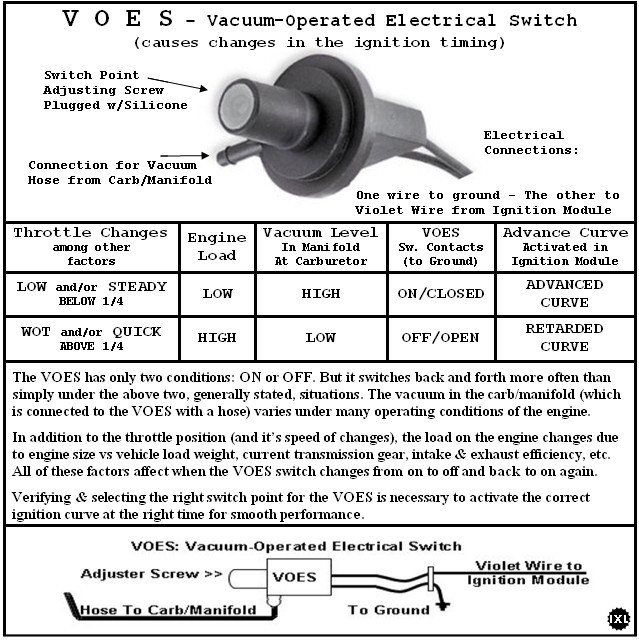 16)
16)
See the explanation of manifold absolute pressure -vs- vacuum gauge readings in the REFerence section on the'Ignition Modules - Aftermarket' page:
http://sportsterpedia.com/doku.php/techtalk:ref:engctl01#manifold_absolute_pressure_-vs-_vacuum_reading
- .
- What it does and how.
- The VOES works in conjuction with the Ignition Control Module (ICM) to control ignition timing. The ICM has two timing curves - one is for idling or cruising and the other is for WOT and/or for powering up for high loads (like steep hills). The VOES switches the ICM between these two pre-programmed advance curves based on manifold vacuum.
- The built-in curves of the ICM vary timing based on the engine RPM. The VOES allows a choice between timing curves based on engine load because the load will vary even though the RPMs are the same (different gears, different terrain, etc.)
- The VOES has two connections and one adjusting screw. The VOES is connected to the carb (manifold side) through a vacuum hose and monitors the manifold vacuum level. It is also connected to the ICM. It has two black wires from the internal switch. From the inline connector, there is a (purple or purple/white) single wire sent to the ICM and a second wire sent to ground. The VOES switching point is set by a concealed screw. This causes the ICM to switch between the two advance curves based on a set point level of manifold vacuum.
- The adjusting screw is inside a sealed opening on the VOES. You must dig out the silicone sealing compound in order to make any adjustments. Remember - When testing your adjustments, you must also seal that opening with your thumb (or other air-tight sealing compound or tape) in order to prevent air leakage through the screw adjuster cavity.
- The only function of the VOES is to switch between the two advance curves that are programed into the ICM. Different ignition modules have a different set of 2 curves. Those two curves have anywhere from 5 to 18 degrees difference in the advance settings between them. But that's another discussion.
- The manifold vacuum directly controls the VOES, but the throttle position (and/or it's aggressive changes) indirectly alters the VOES (thru changes in the manifold vacuum) by altering the carburetor throttle plate.
- When the engine is running at idle, when lightly accelerating or when using a steady cruise throttle, manifold vacuum is high (the throttle plate is mostly closed) and the VOES switch is ON, causing the ICM to use the MORE ADVANCED CURVE.
- When the engine is not running or when the throttle is quickly opened to accelerate or to satisfy a heavy load (steep hill, extra weight, etc.), the manifold vacuum drops and the VOES switch goes OFF, causing the ICM to use the RETARDED (OR LESS ADVANCED) CURVE. If you let off the throttle (when you reach your speed or top the hill), the manifold vacuum rises again. The VOES senses this and will again switch ON, causing the ICM to return to the MORE ADVANCED CURVE as the load on the engine becomes lighter.
- Running without a VOES causes the ICM to run on ONLY the less-advanced power curve. The ICM cannot switch curves. Unless you have a highly modified engine, this will hamper smooth engine operation on light acceleration and reduce fuel savings during cruising.
- Also note, if the VOES switching point is set too low, it will remain on the more advanced curve too long under mid-load acceleration and pinging will occur. This is the reason that engines with upgraded performance should have their VOES switch point increased (switch at a higher vacuum level) to better match the capabilities of the engine.
- Testing the VOES Operation - HD Bulletins
- Method #1 17)
- After the engine timing has been properly checked / adjusted, perform the following check:
- With the engine idling, remove the vacuum hose from the carburetor and momentarily plug the carburetor fitting. Timing will retard and engine speed should decrease. Reinstall the vacuum hose to the carburetor. The timing mark should reappear and engine speed should increase to the preset speed. If the engine speed does not decrease and increase as described, check the VOES wiring connection to the computer module and ground wire. VOES must be replaced if malfunctioning.
- Method #2 18)
- You will need a vacuum pump (with gauge) to create the desired vacuum level and an ohm meter.
See MityVac Vacuum Pump Function and Usage in the Sportsterpedia. - Remove the air cleaner, disconnect the switch wire from the computer module connector under the fuel tank and remove the switch vacuum hose from the carburetor. The rear of fuel tank may have to be raised to disconnect the switch lead connector from the computer module connector.
- Attach the ohmmeter leads to the switch wire and to ground. Attach the vacuum pump hose to the switch vacuum hose.
- The ohmmeter should indicate the switch closed with 3.5 to 4.5 in. of mercury vacuum applied. If more or less vacuum is required to close the switch, replace it.
- Testing the VOES Switch Point
- To test your VOES unit (or adjust it to a specific switching point), you will need a vacuum pump (with gauge) to create the desired vacuum level and an ohm meter to test whether the VOES has switched on (causing a short between it's wires).
- To work on the VOES, remove the vacuum hose from the vacuum line tee where it branches to the vacuum-operated petcock. If you don't have a vacuum-operated petcock, and have no tee, you need to remove the vacuum hose from the carb. Then remove the VOES from it's mount under the fuel tank and disconnect the wires.
- Connect your vacuum pump to the hose and connect your meter (set on ohms) to both wires. As you slowly pump up the vacuum, there will come a point where the meter will switch from infinity to zero ohms. This is the switch point. Write down the indicated vacuum (inches of mercury). Release the vacuum and do the test again, just to be sure you get a consistant reading.
- If the reading is right (according to the manual or chart above) for your bike, you can leave it as it is. If your bike is stock or only upgraded to Stage 1 level, you probably do not need to alter the factory VOES setting. But if you've gone farther with your mods, you might have one of those engine builds where the combination of ignition curves, cams, heads, etc., leaves you with some pinging near the VOES switch point. If you want to make your VOES switch at a different point, read on.
- Adjusting the VOES Switch Point
- Dig out the original sealing compound which fills the opening where the adjusting screw is located. Do this carefully so as not to damage the internal screw or diaphragm or the VOES housing. Remember - When testing your adjustments, you must also seal that opening with your thumb (or other air-tight sealing compound or tape) in order to prevent air leakage through the screw adjuster which will skew your readings.
- To adjust the VOES to switch at a higher vacuum, turn the adjuster screw 1/4 turn clockwise. This causes the ICM to switch to the less advance setting sooner off idle/cruise. Now repeat the test from above to see where (in inches of mercury) the new switch point occurs.
- To switch the VOES at a lower vacuum level, turn the adjuster screw 1/4 turn counter-clockwise. This causes the ICM to switch to the less advance setting later off idle/cruise.
- Keep adjusting the screw (carefully) to raise or lower the switch point. You should not go more than 1 or 2 full turns from the initial setting. If you turn the screw too far clockwise, you'll damage the internal diaphragm and need to replace the unit.
- When you are done making adjustments, you'll need to plug up that hole. But do this very carefully - Be sure you DON'T GET ANY SILICONE DOWN NEAR THE SCREW. Use only enough to plug the end of the opening and then set it aside to fully cure (probably 24 hours) before reinstalling on your bike.
- Variety of VOES
- From the book '101 HD Evo Performance Projects by Kip Woodring & Kenna Love', HD installed VOES on different models with their adjustment set for different switching points. These vacuum settings are measured in inches of mercury. The VOES are color-coded at the sealed end to indicate what setting was used on a particular unit. (I have seen very few with colors other than the natural greyish white - so perhaps HD did not keep up this practice)
- No Color - - - 7.0 in. Mercury – Early Evo FLT (1984)
- RED Color- - - 5.5 in. Mercury – Late Evo FLT
- WHITE Color - 4.0 in. Mercury – Evo FXR & XL
- BLUE Color - - 4.0 in. Mercury – Evo Softail
- All of these VOES should be adjustable to other settings. As far as I know, there is no difference in the various VOES units themselves other than their predefined factory settings.
- The 2003 Sportster Service Manual says the correct Sportster VOES has a Blue paint mark at the vacuum hose fitting 19)
* READER BEWARE!!! …NOT EVERYTHING YOU READ ONLINE IS VALID INFORMATION…
- Additional References:
- For the sake of not repeating what can be looked up directly, the following links have VOES discussions (as well as other info).
- These posts from the above thread are most applicable:
- This post has some great pictures of the inside of the VOES: SubDoc - Dissecting the Voes
Ignition Coil Design
How-it-works by Steelworker: An ignition coil is a pulse-type transformer, consisting of a low voltage primary winding (the input) and a high voltage secondary (output) winding, wrapped around a laminated iron core. The primary circuit is completed by the points or electronic ignition module closing the primary circuit to ground. The flow of current in the primary windings induces a strong magnetic field in the laminated iron core. When the primary circuit is broken (by the ground being removed), the strong magnetic field in the core collapses suddenly, which induces a high voltage electrical discharge out of the secondary circuit, thereby, producing a spark strong enough to bridge the electrode gap of each spark plug.
Testing - In General
To test the coil, you will need a multimeter (or DVM) with a low-resistance scale, preferably a scale of 200 ohms or less. Most coils have a primary resistance below 10 ohms and a secondary resistance in the 1,000's of ohms. When testing the primary resistance, you will connect the meter leads to only the primary connectors. When testing the secondary resistance, you will connect the meter leads, typically, to the coil output towers for the spark plug wires.
If the resistance measurements are lower than specified, that winding has partially shorted, bypassing part of the coil. If the resistance is higher, then corrosion or failing internal connections may be adding to the resistance. If the resistance is infinite, the winding is an open circuit. Failing coils cannot be repaired and need to be replaced with compatible products.
Sometimes coil failure is heat related. In that case, simply idling the bike and heating the coil with a hair dryer may cause the coil malfunction to occur and the spark to stop or become intermittent or erratic.
Two different type coils:
There are two basic ignition systems and HD used different coils for each. The dual-fire ignition systems (thru 2003) use a double-coil built into one housing and both coils are always fired together - One output for the front cylinder and one output for the rear. Both coil outputs fire together when the front cylinder needs a spark and both coil outputs fire together when the rear cylinder needs a spark.
Later (2004+), the single-fire ignition system became standard. It uses a double-coil also built into one housing, BUT, each coil fires separately. One coil is charged and fired when the front cylinder requires a spark and the other coil is charged and fired when the rear cylinder requires a spark. Each coil is SINGLY fired when it's cylinder needs a spark.
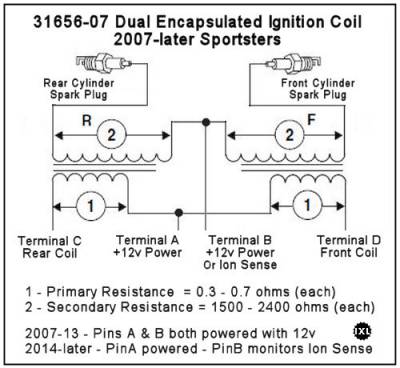
See this thread regarding Knock Sensing in 2014+ models
- https://www.xlforum.net/forum/sportster-motorcycle-forum/sportster-motorcycle-era-specific-and-model-specific/efi-sportster-motorcycle-talk-2007-and-up/191218-do-2014-sportsters-have-spark-knock-control?threadid=2040499
=== Does Ignition Coil Polarity Matter? ===
Up to 2003, the short answer is NO. In fact, the way the dual-fire coils are wound, one plug fires tip to base and the other fires base to tip.22) Most modern coils provide levels of high-voltage (typically, 30,000 volts or more) that exceed any normally required level for standard spark plug gaps.
2004-later (or 98-03 1200S): On connectorized, single-fire coils, be sure any modified wiring matches the connections and polarity specified in the schematics.
See this excellent __XLForum Thread__, especially Post#20 by Fe Head.
=== Why Do I Have Power On Both Coil Terminals? ===
When the primary side of the coil is not being actively triggered, power is flowing into the coil primary windings on one side and passes thru the windings to the other terminal. Therefore, you will see (measure nearly) the same voltage on each terminal when the circuit is idle. But when the coil is actively being triggered (by the ICM/ECM), the trigger wire will ground that side of the coil windings (very briefly) in order to charge up the coil, before releasing the ground to create a spark. Then, back at idle, you will see the same voltage on both terminals.
Ignition Coils - Specs & Checks
(1986-2003 Evo)
The coil is a dual encapsulated unit with two coils in one housing. These coils are interconnected serially to produce a Dual-fire Spark system - The internal front and rear coils both fire at the same time which produces a wasted-spark on the cylinder that is not under compression. This coil has one trigger signal from the ICM which fires both front and rear coils simultaneously. The Primary windings of the coil are typically measured at 3-ohms.
(2004-later Evo)
The coil is a dual encapsulated unit with two coils in one housing. It uses a Single-fire Spark system - The internal front and rear coils each fire their spark plug independently (one cylinder at a time - no wasted spark) when that cylinder is under compression. This coil has a front & a rear trigger signal from the ICM.
(1998-2003 Evo Sport)
These Sport models use a quad encapsulated unit with two dual-coils in one housing. Using dual spark plugs in their heads, these models utilize a Single-fire Spark system - The internal front and rear coils are independent, only firing when their cylinder is under compression. Each (front or rear) dual-coil fires a dual-plug-set. This coil has a front & a rear trigger signal from the ICM.
| Primary | Tower-to-Tower | Output | |||
|---|---|---|---|---|---|
| Years | Part Number | Ohms | Connector | Secondary Ohms | Firing |
| 86-03 | 31614-83A | 2.5 - 3.1 | 2 Lugs | 10,000 - 12,500 | Dual-Fire Both F&R Plugs |
| 04-06 | 31655-99 | 0.5 - 0.7 (A-B or B-C) | 3 Pin | 11,000 - 15,000* | Single-Fire 1 Plug/Spark |
| 07-up | 31656-07 | 0.3 - 0.7 (A-C or A-D) | 4 Pin | 3,000 - 4,800* | Single-Fire 1 Plug/Spark |
| Sport Model | |||||
| 98-03 | 31646-99 | 0.4 - 0.6 (A-B or B-C) | 3 Pin | 11,700 - 12,700 (Twr1-Twr4 or Twr2-Twr3) | Quad Single-Fire 2 Plugs/Cyl/Spark |
* The resistance specification in the manual is for one coil only, measured from PinB to either
. . tower on 04-later models. The tower-to-tower measurement would, therefore, be twice that
. . amount since it represents both coils in series. The doubled value is shown above.
From the manual, 04-06 model is listed as 5500-7500 ohms (for one secondary coil)
23)
From the manual, 07-up model is listed as 1500-2400 ohms (for one secondary coil)
24)
25)
26)
Ignition Coil Testing
- - - - - - - - - - - - - - - - - - - - - - - -
Heat Related Failures (All Years)
Coils are subject to case cracking and internal winding failures due to heat.
These often show up as sputtering, spark missing or simply the engine stops
running after the engine has heated up.
There are two methods of testing the coil relative to heat failures. One method
makes the coil fail when the engine is cold, while the other method tries to make
the coil begin functioning again after it has failed due to heat.
Heat Test - Method #1 - If the bike usually fires when cold but dies when warm/hot, test the coil with the engine cold. With a cold engine, use a hair dryer to blow heat on the coil before attempting to start it. After it's warm, see if the engine fails to start due to the spark missing or intermittent. See checking for spark in the other coil tests.
Heat Test - Method #2 - Once you have a running failure from heat, use 'cold spray' to quickly cool down the coil. If the coil has failed due to heat, this test will see if it will begin to produce a spark again after being cooled down.
These two methods can be used in combination to create & resolve a failure condition. The same procedures can be used to test the ignition module for heat failure.
Grounding the spark plugs when turning over the engine is certainly a reasonable precaution.
Dual-Fire Coil Testing (1986-2003)(Except Sport Model - See Below)
The Dual-Fire Coil has only two primary screw terminals (sometimes labeled, + & -) with dual output towers to the spark plugs. 1986-2003 Evos use a coil rated, nominally, at 3.0 ohms (HD P/N 31614-83A). It has primary terminal studs and the primary wires are nutted onto the coil.
The primary resistance is measured across the two input terminals at 2.5 to 3.1 ohms. Secondary (high voltage) winding resistance is tested from coil tower to coil tower. While the actual specs do vary, typically, the range is 10,000 to 12,500 ohms. Check the FSM for the exact primary and secondary coil resistance for your model year.
(Note that Ironheads with points typically use a dual-fire coil with a nominal primary resistance of 5.0 ohms.)
Quad Single-Fire (Quad) Coil Testing (Sportster Sport 1998-2003)
The Sport model is unique - It has two spark plugs in each head. This means the coil must fire two pairs of spark plugs. To do this, the Sport model coil (HD P/N 31646-99) has four internal coils in one housing. They are wired so both front cylinder spark plugs are fired together by two of the coils and then the rear cylinder set of plugs are fired by the other set of coils.
The coil output towers exit at right angles to the Sportster frame. The Front (Left & Right) towers fire the two plugs in the front head. The Rear (Left & Right) towers fire the two plugs in the rear head. The coil primary windings are connected using a 3-pin connector located on the coil just below the upper frame.
The coil has three connectorized primary terminals referenced as pin A(Front), B(V+) and C(Rear). Pin A & C connect the appropriate firing signals and primary terminal pin B(V+) is common to all internal coils. Primary resistance from pin B(V+) to pin A(Front) is 0.4 to 0.6 ohms and likewise the same for pin B(V+) to pin C(Rear). The secondary resistance measurement is taken between both front coil towers (L&R) and then again between both rear coil towers (L&R). The measurement for each is 11,700 to 12,700 ohms.
Single-Fire Coil Testing
The Single-Fire Coil has a separate firing signal input for the Front & Rear plugs.
2004-2006 models - The coil (HD P/N 31655-99) has three connectorized primary terminals referenced as pin A(Rear), B(V+) and C(Front). These same pins are also referenced as 1, 2 & 3, respectively. Pin A & C connect the appropriate firing signals and primary terminal pin B(V+) is common to both internal coils. Primary resistance from pin B(V+) to pin A(Rear) is 0.5 to 0.7 ohms and likewise the same for pin B(V+) to pin C(Front).
You can test the secondary resistance of each individual coil by placing one meter lead on the B(V+) input terminal and then placing the other meter lead on one of the output towers - Taking the reading this way should produce a resistance reading within the range specified in the manual, 5500-7500 ohms. If you test the secondary resistance between both towers (one lead in each tower) you should obtain a reading equal to the sum of the two previous readings - or 2x the spec - Here, that would be a reading between 11,000 & 15,000 ohms.
2007-2013 models - With the introduction of EFI, the single-fire coil (HD P/N 31656-07) has four (4) connector pins in the connectorized primary connector. Looking into the connector on the coil (when the towers are pointing down), the pins (left-to-right) are defined as A(Power), B(Power), C(Rear) & D(Front). Both PinA & PinB are supplied power together by the connecting cable. The C(Rear) & D(Front) pins are the trigger signals, which are grounded by the Engine Control Module (ECM) to charge the coil and released from ground to fire the coil.
Measuring primary coil resistance from pin A to pin D should read 0.3 to 0.7 ohm. Likewise, from pin A to pin C should measure 0.3 to 0.7 ohm.
Maybe» Although PinB is supplied power, it is believed that PinB is connected between the two secondary coils, allowing for the future implementation of ION Sense, the ability to detect combustion when the spark plug fires.
You can test the secondary resistance of each individual coil by placing one meter lead on the PinB terminal and then placing the other meter lead on one of the output towers - Taking the reading this way should produce a resistance reading within the range specified in the manual, 1500-2400 ohms. If you test the secondary resistance between both towers (one lead in each tower) you should obtain a reading equal to the sum of the two previous readings - or 2x the spec - Here, that would be a reading between 3,000 & 4,800 ohms.
When the keyswitch is turned ON (with RUN/Stop in RUN), the ECM causes the ignition power to be on for 2-3 seconds to prime the pressure in the fuel system. Then, the ECM turns off the System Relay and waits for further action by the rider. The System Relay will be activated for ignition power (to the fuel pump, coil & injectors) when the ECM sees CKP pulses (as when the starter is running). If the engine is not running or being cranked (no CKP pulses), the ECM will de-energize the system relay within a few seconds.
2014-later models - The operation for these years is the same as above, except for PinB. In 2014, with the implementation of the CANbus, PinB began to be used for ION Sense, with a separate wire back to the ECM (Pin9). ION Sense allows the ECM to sense combustion when the spark plug fires.
Manually Trigger Coils For Testing Spark
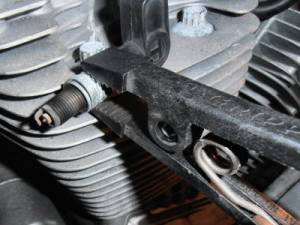 1986-1990
1986-1990
The Ignition Control Module (ICM) is located rearward of the battery behind the triangular cover. The ICM is directly wired to the main harness or it's related components. THERE IS NO CONNECTOR TO USE FOR TESTING. You will need to test at the coil.
On the coil, the BLUE Wire is the trigger wire from the Ignition Control Module & the PINK Wire goes to the Tachometer. The WHITE Wire(s) are power from the Run/Stop Switch. On later version retrofit modules for 86-90, the trigger wire may be a PINK Wire, since the 1991-later connectorized stock modules used a PINK Wire for the trigger signal.
Remove the BLUE & PINK Wires from the coil - There should now be no wires on that electrical post of the coil. Leave the WHITE wire(s) connected to the other electrical post.
Connect an appropriate length wire to a solid ground point on the frame, long enough to reach the coil. Remove your spark plugs and ground them to a solid ground point (like the fins) where you can observe the elements for a spark. You can always use an extra hand clamp.
Turn the keyswitch fully on - Flip the Run/Stop switch to RUN.
Briefly ground the coil by touching your ground wire to the coil electrical post where the BLUE & PINK Wires were previously connected. This will charge the coil and it should fire a blue spark on both plugs when you remove the wire from the coil. A blue spark indicates a strong power level. A yellow spark indicates low power.
This will test the coil, spark plug wires & spark plugs to verify a spark is able to be produced. Power down and put everything back where it belongs.
If this test fails to produce a spark at each spark plug, and the spark plug wires and spark plugs are functional, then the coil itself is suspect. A (temporary) replacement coil should be utilized and the test performed again.
1991-1993
The Ignition Control Module (ICM) is located rearward of the battery behind the triangular cover. It connects to the main harness at Connector 10A/B - a seven-pin connector located behind the battery near the circuit breakers.
Remove connector 10A from 10B - On the pin side (10A), which goes to the main harness, Pin#4 (BLACK Wire) is connected to the main ground while Pin#1 (PINK Wire) provides the trigger for the coil.
Remove your spark plugs and ground them to a solid ground point (like the fins) where you can observe the elements for a spark. Turn the keyswitch fully on - Flip the Run/Stop switch to RUN.
NOTE: VERIFY YOUR CONNECTIONS BY COLOR (BLACK & PINK) - TAKE CARE NOT TO SHORT ANY OTHER PINS
Use a short piece of wire to briefly short Pin#4 (BLACK) to Pin#1 (PINK) on Cable Connector 10A - By briefly shorting these pins, you will charge the coil and it should fire a blue spark on both plugs when you remove the wire from those pins. A blue spark indicates a strong power level. A yellow spark indicates low power.
This not only tests the coils, but all the wiring from the 10A/B connector to the Spark Plugs. Power down and put everything back where it belongs.
If this test fails to produce a spark at each spark plug, and the spark plug wires and spark plugs are functional, then the coil itself is suspect. A (temporary) replacement coil should be utilized and the test performed again.
1994-1997
The Ignition Control Module (ICM) is located rearward of the battery behind the triangular cover. It connects to the main harness at Connector 10A/B - an eight-pin connector located behind the battery near the circuit breakers.
Remove connector 10A from 10B - On the pin side (10A), which goes to the main harness, Pin#7 (BLACK Wire) is connected to the main ground while Pin#4 (PINK Wire) provides the trigger for the coil.
Remove your spark plugs and ground them to a solid ground point (like the fins) where you can observe the elements for a spark. Turn the keyswitch fully on - Flip the Run/Stop switch to RUN.
NOTE: VERIFY YOUR CONNECTIONS BY COLOR (BLACK & PINK) - TAKE CARE NOT TO SHORT ANY OTHER PINS
Use a short piece of wire to briefly short Pin#7 (BLACK) to Pin#4 (PINK) on Cable Connector 10A - By briefly shorting these pins, you will charge the coil and it should fire a blue spark on both plugs when you remove the wire from those pins. A blue spark indicates a strong power level. A yellow spark indicates low power.
This not only tests the coils, but all the wiring from the 10A/B connector to the Spark Plugs. Power down and put everything back where it belongs.
If this test fails to produce a spark at each spark plug, and the spark plug wires and spark plugs are functional, then the coil itself is suspect. A (temporary) replacement coil should be utilized and the test performed again.
1998-2003 ALL Except Sport Model
The Ignition Control Module (ICM) is located behind the small timing cover on the Cam Cover. It connects to the main harness at Connector 10A/B - a six-pin connector located under the engine.
With your Keyswitch OFF, remove connector 10A from 10B - On the socket side (10B), which goes to the main harness, Pin#6 (BLACK Wire) is connected to the main ground while Pin#4 (PINK Wire) provides the trigger for the coil. (Some early versions may have the PINK Wire on Pin#5. Make sure you identify the PINK wire.) Take a short piece of wire (paper clip?) and ground one end by inserting it into Pin#6. Place the other end of the jumper wire into the PINK wire socket (likely, Pin#4).
NOTE: VERIFY YOUR CONNECTIONS BY COLOR (BLACK & PINK) - TAKE CARE NOT TO SHORT ANY OTHER PINS
Remove your spark plugs and ground both of them to a solid ground point (like the fins) where you can observe the elements for a spark. Keep them tight to the fins (spring clamp) for a good electrical connection.
Keep the RUN/STOP switch OFF - Turn the keyswitch fully ON. Now, very briefly, flip the RUN/STOP switch to RUN and then back to OFF. Do this several times (just a brief flick ON then OFF) to see consistent creation of sparks.
By this brief power flicking, you will charge the coil and it should fire a blue spark on both plugs when the RUN/STOP switch is flicked OFF. A blue spark indicates a strong power level. A yellow spark indicates low power.
This not only tests the coil operation, but all the wiring from the 10A/B connector to the Spark Plugs. Power down and put everything back where it belongs.
If this test fails to produce a spark at each spark plug, and the spark plug wires and spark plugs are functional, then the coil itself is suspect. A (temporary) replacement coil should be utilized and the test performed again.
1998-2003 (Sport Model only)
The Ignition Control Module (ICM) is located under the seat. It connects to the main harness with two 12-pin connectors - one Gray Connector (11A/B) and one Black Connector (10A/B) - We want to disconnect both, but will only be working with the 10B socket connector.
Remove connectors 11B and 10B from the ICM - On the socket side of 10B (the Black connector), which goes to the main harness, Pin#2 (BLACK Wire) is connected to the main ground while Pin#6 (BLUE/Orange Wire - Front) and Pin#7 (YELLOW/Blue Wire - Rear) provide the triggers for the dual-coil.
Now take a short piece of wire (paper clip?) and ground one end by inserting it into Pin#2.
Remove your front cylinder spark plugs and ground them to a solid ground point (like the fins) where you can observe the elements for a spark.
-or-
Remove your rear cylinder spark plugs and ground them to a solid ground point (like the fins) where you can observe the elements for a spark.
Turn the keyswitch fully on - Flip the Run/Stop switch to RUN.
Very briefly, touch the ground wire to Pin#6 of Cable Connector 10B (the connector on the cable, not on the ICM itself) - By briefly touching that pin, you will charge the coil for the FRONT plugs and it should fire the front cylinder spark plugs when you remove the wire from Pin#6. A blue spark indicates a strong power level. A yellow spark indicates low power.
-or-
Very briefly, touch the ground wire to Pin#7 of Cable Connector 10B (the connector on the cable, not on the ICM itself) - By briefly touching that pin, you will charge the coil for the FRONT plugs and it should fire the front cylinder spark plugs when you remove the wire from Pin#7. A blue spark indicates a strong power level. A yellow spark indicates low power.
This not only tests the coils, but all the wiring from ICM to the Spark Plugs. Power down and put everything back where it belongs.
If this test fails to produce a spark at each spark plug, and the spark plug wires and spark plugs are functional, then the coil itself is suspect. A (temporary) replacement coil should be utilized and the test performed again.
| On 2004-later models, the ICM will not fire during engine turn over with both spark plugs removed. At least one spark plug must be installed to create engine compression. For simplicity, for all 2004-later spark tests, you can use a spare, known good, spark plug that is grounded to the engine fins. Connect the spark plug wire under test to the spare spark plug rather than removing the original in-cylinder spark plug. 27) |
|---|
2004-2006 28)
Find the Ignition Control Module (ICM) under the seat - Remove the connector from the ICM (12 pin connector known as 10A/B). On that connector, Pin#5 (BLACK Wire) is connected to the main ground while Pin#6 (BLUE/Orange Wire - Front) and Pin#7 (YELLOW/Blue Wire - Rear) provide the triggers for the dual-coil.
Now take a short piece of wire (paper clip?) to use as a jumper and ground one end by inserting it into Pin#5. Connect a spare spark plug to the front spark plug wire and ground the plug to a solid ground point (like the fins) where you can observe the elements for a spark.
Turn the keyswitch fully on - Flip the Run/Stop switch to RUN.
Now, very briefly, touch the grounded jumper wire to Pin#6 of Cable Connector 10B (the connector on the cable, not on the ICM itself) - By briefly touching that pin, you will charge the coil for the FRONT sparkplug and it should fire a spark on the spare plug when you remove the jumper wire from Pin#6. A blue spark indicates a strong power level. A yellow spark indicates low power.
Remove the front spark plug cable from the spare plug. Connect the rear spark plug cable to the spare plug and be sure spare plug is grounded to the fins.
Now briefly touch the grounded jumper wire to Pin#7 of Cable Connector 10B - This will energize the coil for the REAR sparkplug and when the jumper wire is removed that coil should fire the spare plug thru the rear spark plug cable. A blue spark indicates a strong power level. A yellow spark indicates low power.
This not only tests the coils, but all the wiring from ICM to the Spark Plugs. Power down and put everything back where it belongs.
If this test fails to produce a strong, bright spark at each spark plug, and the spark plug wires and spark plugs are functional, then the coil itself is suspect. A (temporary) replacement coil should be utilized and the test performed again.
2007-2013
With the implementation of the Eletronic Fuel Injection Ignition System, there is now a System Relay. The Engine Control Module (ECM) is located under the seat.
Remove the connector from the ECM (36 pin connector known as 78A/B). On the socket connector (78B), Pin#10 (BLACK Wire) is connected to the main ground while Pin#29 (BLUE/Orange Wire - Front) and Pin#11 (YELLOW/Blue Wire - Rear) provide the triggers for the dual-coil. Pin#2 provides the grounding activation for the System Relay.
Take a short piece of wire (paper clip?) and ground one end by inserting it into Pin#10. Then, place the other end into Pin#2 to create the missing activation signal for the System Relay. Remove your spark plugs and ground them to a solid ground point (like the fins) where you can observe the elements for a spark.
Place another short piece of wire (paper clip?) into Pin#11 and short it to Pin#10. Turn the Run/Stop switch to OFF/STOP - Turn the keyswitch fully on. Now, briefly, flip the Run/Stop switch to RUN and then back to OFF/STOP. By briefly activating the RUN switch, you will charge the coil for the REAR cylinder and it should fire the rear spark plug when you switch back to OFF/STOP. Turn the keyswith to OFF. A blue spark indicates a strong power level. A yellow spark indicates low power.
Remove the wire from Pin#11 and place it into Pin#29 and short it to Pin#10. Turn the Run/Stop switch to OFF/STOP - Turn the keyswitch fully on. Now, briefly, flip the Run/Stop switch to RUN and then back to OFF/STOP. By briefly activating the RUN switch, you will charge the coil for the FRONT cylinder and it should fire the front spark plug when you switch back to OFF/STOP. A blue spark indicates a strong power level. A yellow spark indicates low power.
Turn the keyswith to OFF.
This not only tests the coils, but all the wiring from ICM to the Spark Plugs. Power down and put everything back where it belongs.
If this test fails to produce a spark at each spark plug, and the spark plug wires and spark plugs are functional, then the coil itself is suspect. A (temporary) replacement coil should be utilized and the test performed again.
2014-later
Because the ECM/BCM is so fully integrated with all the operating components, it controls power to the coil. It is no longer a simple matter to test from the ECM to the coil.
Manually Trigger The Ignition Control Module For Testing Spark
- - - - - - - - - - - - - - - - - - - - - - - -
This information ONLY applies to 1986-1997 All Models & 1998-2003 'S' Models
These models use a Cam Position Sensor (CPS) Plate that is separate from the Ignition Control Module.
This information does not apply to the non-'S' models of 1998-2003 which use an integrated Ignition Control Module on the CPS Plate in the nosecone. It also does not apply to 2004-later models which use a Crankshaft Position Sensor (CKP) instead of a Cam Position Sensor.
The CPS connects thru the main wire harness to the Ignition Control Module. It uses a 3-pin connector, known as 14A/B. It is located under the engine (left side near the kick stand). The 14A (plug) comes from the Cam Position Sensor Unit - the 14B (socket) is on the main harness and goes to the ICM.
On Connector 14B (3-pins), the wires function as follows:
- Pin(A) Red/White - 12v Power from ICM to CPS - 5v power for 1998-2003 'S' Models 29)
- Pin(B) Green/White - Rotor Signal from CPS to ICM
- Pin(C) Black/White - Ground from ICM to CPS
These diagrams show the CPS mating connector on the Main Harness:
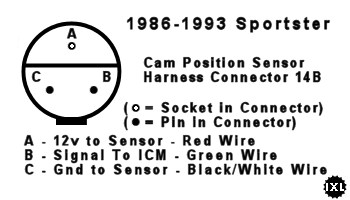 30)
30) 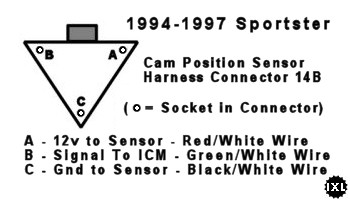 31)
31)
(Note: the 1998-2003 Sport model uses the same CPS & Connector as the 1994-1997 models. The slotted rotor cup is different on the Sport models, having additional slots to allow for the single-fire ignition. Note also, with the new ICM module and the addition of a MAP Sensor, the power to the Cam Position Sensor is 5v (5v also to the MAP Sensor) for the 1998-2003 'S' models.)
Testing the ability of the ICM to sense the Cam Rotor & fire the Coil
- With the rest of the wiring in tact, disconnect the Connector 14A/B
- Turn the Keyswitch to ON & place the RUN/STOP switch in the RUN position
- Using harness Connector 14B (which goes to the ICM), briefly short Pin(B) to Pin(C) using a paper clip in the sockets
- Note: The first four signals are ignored so do this 6-10 times
- After the first four times, when the short is broken, the ICM should fire the coil & produce a blue spark.
- A blue spark indicates a strong power level. A yellow spark indicates low power.
- (CAUTION - Never short (A) to either other pin or to ground)
If this test succeeds, yet no spark is produced when cranking the engine with the CPS connected, then the Cam Position Sensor is suspect and may need replacing. (Note: The CPS fails very rarely. Double check your testing. But you can also test the CPS - See Here.)
If the above test fails to produce a spark at each spark plug, and the spark plugs, plug wires and coil are functional, then the Ignition Control Module itself is suspect. (Note: The Ignition Control Module rarely fails.) Use a (temporary) replacement ICM and run the tests again.
Spark Plugs
| Year Model | Use/Type HD Plug | Alt. Plug Brand/Number | Ignition Type Spark Gap | |
|---|---|---|---|---|
| 1986-2016 | HD 6R12 (resistor type) | Autolite 4164 Bosch YR6LDE Champion RA8HC NGK DCPR7E Screamin Eagle EX12S | Electronic Ign. 0.038-0.043“ 12mmX1.25mm Threads - 12-18 ftlbs torque Wrench = 5/8” or 16mm |
|
FYI: Buell Ignition Modules
Note: (From aswracing in this post on the xlforum)
The Buell X1 was only made from 1999-2002. It is EFI based, with a single ECM (engine control module) that controls both spark and fueling. No separate ignition module at all. The same is true for all 1999-2002 Buell S3 models. The parts books refer to the ECM as a “control module”.
The 2001-2002 ignition module found on the M2 is an actual ignition module. Since the M2 is carbureted, the module provides control only of the spark advance but no control of fueling. Although it has a similar appearance to the ECM found on 1999-2002 X1 & S3 models, the part number is different and the parts books refer to it as an “ignition module”. This 2001-2002 M2 ignition module is also a bastard, not found on any other Harley or Buell, and no aftermarket replacements available for it. The only high performance version of it I've ever seen was the Buell Pro-Series version which was offered back in the day. It's an issue when someone comes to us for a performance package for a 2001-2002 M2. We basically have to tell him to chuck it and wire in a nose cone module.
The other carbureted Buell models (1995-1996 S2, 1996-1998 S1/S1W, 1997-2000 M2, and 1997-1998 S3) all came with 8-pin modules, except 49-state 1995 S2's, which came with 7-pin modules. These are similar to the XL version ignition modules.
There's an adapter available to connect an 8-pin module to a 7-pin bike, and another one available to go the other direction, i.e. a 7-pin module to an 8-pin bike.

